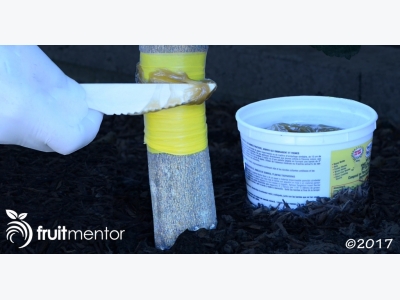Organic Ant Control for Citrus Trees – Tanglefoot Sticky Barriers

This article demonstrates organic ant control for citrus trees using tree tanglefoot, a natural ant repellent for fruit trees. Because nectar-loving ants such as the Argentine ant farm nectar-producing insects such as the Asian citrus psyllid, controlling ants on citrus trees is an important measure to reduce the spread of Huanglongbing, a deadly citrus disease spread by citrus psyllids.
Tanglefoot sticky barrier applied to a lemon tree.
Organic Ant Control for Citrus Trees – Tanglefoot Sticky Barriers – YouTube video
In addition to this article, I have also made a YouTube video (see below) demonstrating how to keep ants off of citrus trees by applying tree tanglefoot.
Argentine Ants
The Argentine ant is one of the worst invasive species. From its native Paraná River basin, it has spread to six continents, aggressively displacing native ant species and disrupting ecosystems. California has a supercolony of Argentine ants that covers most urban areas. Because introduced Argentine ant populations lack the genetic diversity of native populations, the ants treat one another as family. The resulting lack of aggression within the introduced colonies gives them an advantage over many native ant species.

Worldwide spread of the argentine ant.
Ants a Big Problem for Citrus Trees
Ants are a major pest of citrus trees and can indirectly kill citrus trees in combination with the Asian citrus psyllid and Huanglongbing, a fatal and incurable disease of citrus spread by citrus psyllids. Due to the spread of the Asian citrus psyllid and Huanglongbing, California is in danger of losing its citrus trees.

Argentine ants harvesting sweet honeydew produced by Asian citrus psyllids.
Beneficial Parasitic Wasps Disrupted by Ants
Parasitic wasps exist in California that are very effective in killing Asian citrus psyllids and reducing their numbers. The below video shows Tamarixia radiata, one of the parasitic wasp species, parasitizing an Asian citrus psyllid.
Ants protect citrus psyllids from parasitic wasps so that they can harvest the sugary honeydew produced by the psyllids. If ants are present on a citrus tree, the parasitic wasps are much less effective and the population of the disease-spreading citrus psyllids will increase. The below video shows Argentine ants protecting Asian citrus psyllids from Tamarixia radiata.
Even if citrus psyllids are not present, ants protect many kinds of insect pests of citrus from natural predators. Basic organic pest control of citrus trees is to keep ants off of the trees so that predators can kill the harmful pests.

Cottony cushion scale tended by Argentine ants.
Wrapping the Tree
It is important not to apply the sticky barrier directly to the bark of a citrus tree. If applied directly, it would damage the tree. To keep the sticky barrier off of the trunk, I first wrap it with vinyl tape. The wrapping must be tight enough that ants cannot crawl under the barrier.

Wrapping the citrus tree with vinyl tape.
Applying the Tree Tanglefoot Sticky Barrier
Tanglefoot is difficult to remove from hands and utensils, so I use disposable gloves and a disposable knife. Using a disposable knife, I apply the tree tanglefoot sticky barrier directly to the wrapping material. It is important to periodically check the sticky barrier to make sure that no bridges allowing ants to cross have been formed by debris. If such a bridge forms it can be removed by using another disposable knife to disturb the barrier and expose a sticky layer underneath the debris.

Applying tree tanglefoot to the tree.
Eliminating Paths Around the Sticky Barrier
The biggest problem with sticky barriers is that ants can find ways around them. If there is any other path between the tree and the ground other than the trunk, ants will find it. For sticky barriers to be effective, trees must be pruned to keep branches from touching fences or any other path to the ground.

Paths to the ground from this citrus tree were removed so that the sticky barrier would be effective.
Replacing the Sticky Barrier
I remove and replace the sticky barrier every year to avoid damage to the tree.

Removing the sticky barrier.
Ant Baits are an Alternate Method of Ant Control
In some situations I have found it very difficult to keep ants off of my trees with sticky barriers. One example is a planting of closely-spaced citrus trees near a fence. An alternative to sticky barriers is ant baits. My next article will be on ant control with liquid ant baits.
Có thể bạn quan tâm
 Policies hinders trading of local agricultural products
Policies hinders trading of local agricultural products Policies continue to discourage the production and trade of local agricultural products, research findings by the Institute of Policy & Strategy for Agriculture
 ’Don’t export livestock’: official
’Don’t export livestock’: official Vu Van Tam, Deputy Minister of Agriculture and Rural Development, tells Countryside Today newspaper that enterprises should only export processed products
 US halts Brazil beef imports, citing food safety concerns
US halts Brazil beef imports, citing food safety concerns The United States announced Thursday a halt to all imports of fresh beef from Brazil, the world's second-largest producer, citing recurring food safety concerns